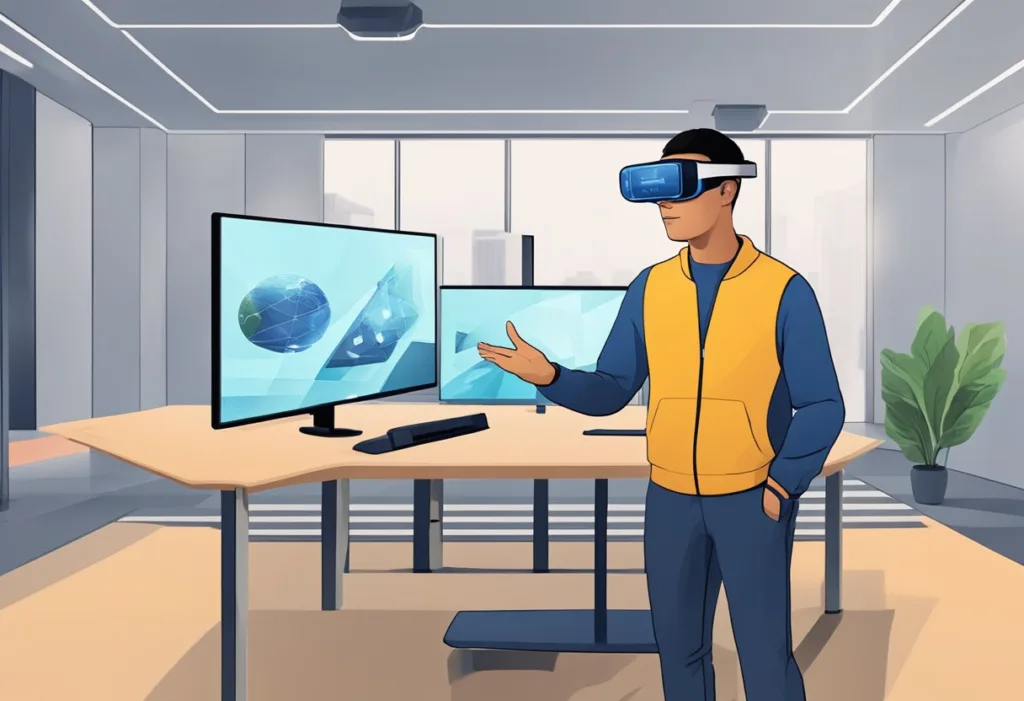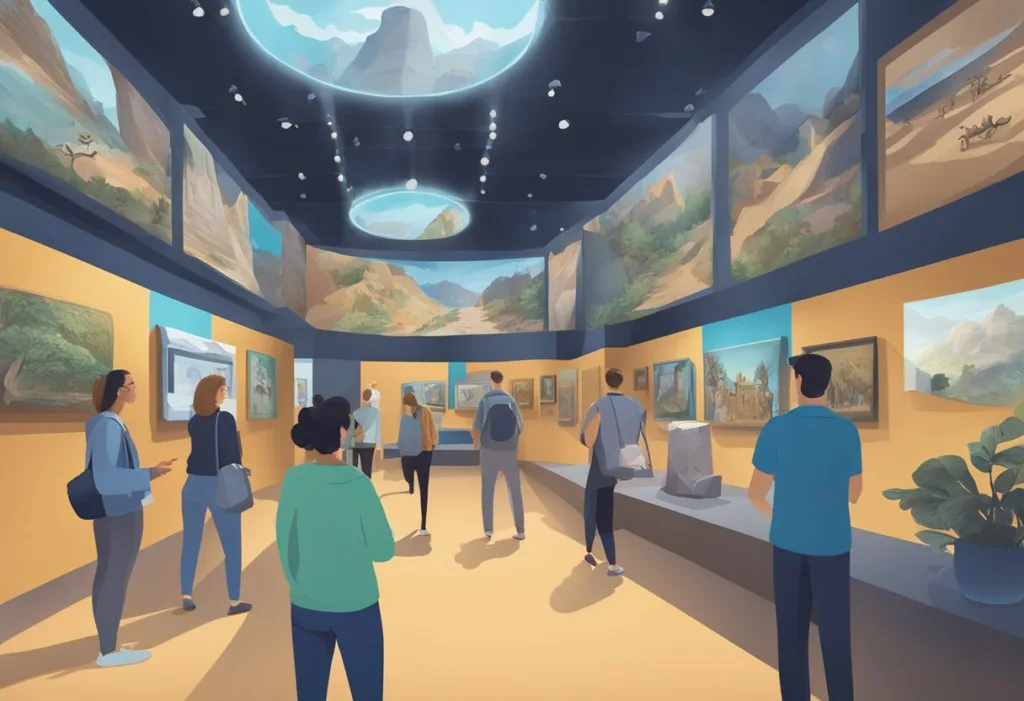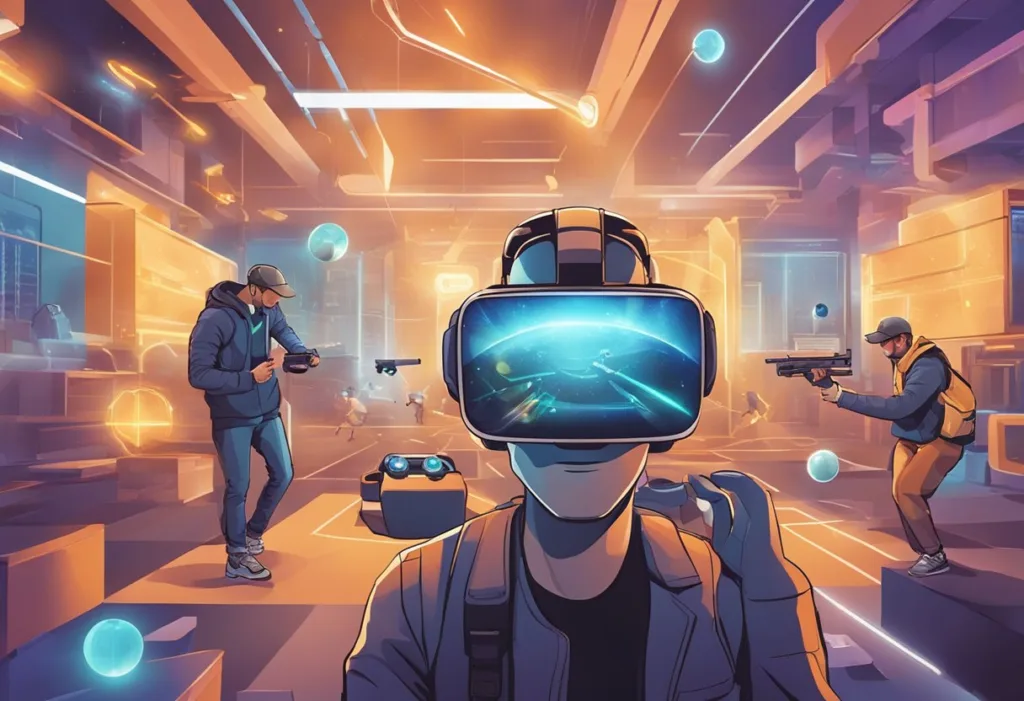Augmented reality (AR) is a technology that overlays digital information onto the real world, creating an interactive and immersive experience. AR can be used for a variety of purposes, including training. The use of AR in training has been gaining popularity in recent years, as it has been shown to improve learning outcomes and engagement. In this article, I will discuss augmented reality for training and share with you the benefits and top platforms to get started.
AR can be used to create simulations and scenarios that allow learners to practice skills in a safe and controlled environment. This can be especially useful in industries such as healthcare, where mistakes can have serious consequences. By using AR, learners can gain experience and confidence without the risk of harming patients. AR can be used to create more engaging and interactive training experiences, which can lead to better retention of information and increased motivation to learn.
Key Takeaways
- Augmented reality (AR) is a technology that overlays digital information onto the real world, creating an interactive and immersive experience.
- AR can be used to create simulations and scenarios that allow learners to practice skills in a safe and controlled environment.
- AR can be used to create more engaging and interactive training experiences, which can lead to better retention of information and increased motivation to learn.
Fundamentals of Augmented Reality
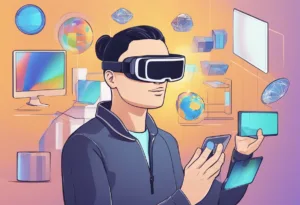
Augmented Reality (AR) is a technology that overlays digital information onto the real world. It enhances the user’s perception of reality by adding computer-generated elements to the physical world. AR technology has been around for a while, but it has gained popularity in recent years due to advancements in computer graphics and mobile devices.
Understanding AR Technology
AR technology works by using cameras, sensors, and computer processors to detect and track real-world objects. It then adds digital content to the user’s view of the real world through a device such as a smartphone or AR headset. This technology can be used for a variety of purposes, including entertainment, education, and training.
AR technology is based on the concept of computer vision, which allows computers to interpret and understand visual information from the real world. This technology is used to recognize and track objects in the real world, and to overlay digital content onto them.
AR vs. VR: Clarifying the Differences
AR and Virtual Reality (VR) are often confused, but they are different technologies. While AR overlays digital information onto the real world, VR creates a completely virtual world that the user can interact with. AR enhances the user’s perception of reality, while VR replaces it.
AR is useful for training because it allows users to interact with the real world while still receiving digital information. This can be particularly helpful for hands-on training, where users need to see and manipulate real-world objects. AR technology is becoming increasingly accessible, with many smartphones and tablets now capable of running AR applications.
AR technology is a promising tool for training, with many potential applications in a variety of industries. As the technology continues to improve and become more accessible, it is likely that we will see more and more AR applications for training and education.
Advantages of AR in Training
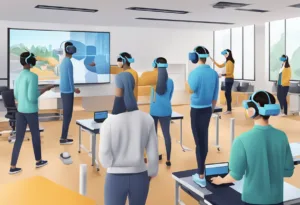
Enhanced Engagement and Retention
Using augmented reality for training significantly enhances learner engagement and retention rates. AR provides an interactive environment that transforms traditional learning methods into captivating experiences. When trainees are actively engaged with content that responds to their actions, they are more likely to absorb and recall information. This is especially true for complex or abstract concepts that can be difficult to grasp through conventional means.
AR’s immersive nature allows for practical, hands-on learning without the risks associated with real-world training, such as in medical or heavy machinery operation scenarios. The multisensory experience not only caters to various learning styles but also promotes active learning, ensuring that knowledge is retained longer than with passive teaching methods.
Real-time Feedback and Assessment
Augmented reality for training offers the advantage of providing immediate feedback to learners. As trainees interact with AR simulations, the system can track their actions and give instant responses to correct mistakes or reinforce good practices. This instant feedback loop is crucial for effective learning, as it allows users to understand their errors and correct them in real-time, leading to improved performance.
Moreover, AR can assess trainees’ performance through built-in analytics and provide detailed reports on their progress. This data-driven approach to assessment helps trainers identify areas where learners may struggle and tailor the training program accordingly, leading to more personalized and efficient training outcomes.
Safe and Controlled Learning Environment
One of the key benefits of augmented reality for training is the creation of a safe and controlled learning environment. AR allows trainees to practice skills and procedures without the risks associated with real-life training. For instance, AR can simulate hazardous situations for emergency response training, allowing trainees to gain experience without the danger of actual harm.
In industries like aviation, healthcare, or manufacturing, where mistakes can be costly or dangerous, AR provides a platform for trainees to learn, make mistakes, and master skills in a risk-free setting. This not only protects the trainees but also ensures that when they transition to real-world scenarios, they are well-prepared and confident in their abilities.
Cost-Effective Training Solutions
Augmented reality for training is a cost-effective solution compared to traditional training methods. Traditional training often requires physical materials, travel, and specialized equipment, all of which can be expensive. AR eliminates many of these costs by allowing trainees to use virtual equipment and scenarios instead.
Moreover, AR can reduce the need for physical prototypes or models, as these can be simulated virtually with great detail. AR training can be easily scaled and updated without the same level of additional costs, providing businesses with a more sustainable and long-term training investment.
Flexibility and Accessibility
Flexibility and accessibility are significant advantages when using augmented reality for training. AR applications can be accessed on various devices such as smartphones, tablets, and AR glasses, making training materials available to a broader audience regardless of location.
This means that employees can train at their own pace and schedule, leading to less disruption in their daily work and the ability to balance training with other responsibilities. For organizations with a global or remote workforce, AR training ensures consistent training standards and experiences across the board, without the need for costly and time-consuming travel.
Accelerated Learning Curve
Augmented reality for training accelerates the learning curve by allowing trainees to visualize and practice complex processes in an intuitive way. AR’s ability to overlay information onto the real world means that learners can see the direct application of their training in a live environment.
For example, AR can demonstrate machinery operations step by step, providing a clear and interactive guide that is easier to follow than traditional manuals or videos. This accelerated learning process not only shortens the time it takes for trainees to become proficient but also increases the overall efficiency of the training program.
Enhanced Collaboration and Teamwork
Augmented reality for training also fosters enhanced collaboration and teamwork among trainees. AR enables multiple users to view and interact with the same virtual objects or scenarios simultaneously, even if they are in different physical locations. This collaborative aspect of AR training encourages communication and teamwork, as trainees must work together to solve problems or complete tasks.
In scenarios where team coordination is critical, such as in surgical procedures or military operations, AR provides a platform for teams to practice and hone their collaborative skills. This can lead to improved team dynamics and better outcomes in real-world collaborative tasks.
Top Platforms for Augmented Reality Training
- TeamViewer Frontline
- Onsight Augmented Reality Platform
- TeamViewer Pilot
- Dynamics 365 Guides
- Help Lightning
- ARKit
- ARCore
- Unity
- Vuforia
- Wikitude
TeamViewer Frontline
TeamViewer Frontline is an augmented reality for training tool designed to assist frontline workers with hands-free operation and remote expert guidance. This solution enables workers to receive visual instructions and data overlays on smart glasses or mobile devices, allowing them to perform tasks with increased accuracy and efficiency. TeamViewer Frontline is particularly useful in industries such as manufacturing, logistics, and maintenance, where precision and quick access to information are crucial.
Onsight Augmented Reality Platform
The Onsight Augmented Reality Platform is a powerful tool for augmented reality for training, providing remote collaboration and expert support in real-time. It allows experts to see what the field worker sees and guide them through complex processes using AR annotations. This tool is beneficial for training purposes as it accelerates knowledge transfer, reduces travel costs, and increases the effectiveness of on-the-job training.
TeamViewer Pilot
TeamViewer Pilot is an augmented reality for training application that enables experts to remotely guide and support users through complex tasks. By sharing the user’s view through their smartphone camera, experts can draw and place 3D markers on real-world objects to provide visual instructions. This tool is invaluable for training employees in remote locations or for providing immediate assistance without the need for an expert to be physically present.
Dynamics 365 Guides
Dynamics 365 Guides is a tool that leverages augmented reality for training by providing step-by-step holographic instructions directly in the user’s field of view. This Microsoft tool integrates with HoloLens to create immersive training experiences that improve learning retention and operational performance. It is particularly useful for hands-on training in manufacturing, repair, and assembly operations.
Help Lightning
Help Lightning is an augmented reality for training software that merges two real-time video streams, allowing experts to virtually reach out and touch what their trainee is working on. This “merged reality” experience enhances remote assistance and training, enabling experts to demonstrate techniques and guide trainees as if they were in the same physical space.
ARKit
ARKit is Apple’s framework for augmented reality for training, providing developers with tools to create AR experiences on iOS devices. For training purposes, ARKit can be used to create apps that offer interactive 3D models, simulations, and real-world overlays, which can enhance the learning process for various educational and professional training scenarios.
ARCore
ARCore is Google’s platform for building augmented reality for training applications on Android devices. It enables developers to create immersive and interactive training experiences by understanding the environment, detecting surfaces, and estimating lighting conditions. ARCore is instrumental in developing training tools that can scale across a wide range of Android devices, making AR training more accessible.
Unity
Unity is a game development platform that is also widely used for creating augmented reality for training applications. With its AR Foundation toolkit, Unity allows for the development of cross-platform AR experiences that can be deployed on both iOS and Android devices. Its robust set of features and large asset store make it an ideal choice for developing interactive and immersive training applications.
Vuforia
Vuforia is a comprehensive augmented reality for training SDK that enables developers to create highly interactive and engaging training applications. With features such as image recognition, object tracking, and area learning, Vuforia allows for the creation of detailed AR training tools that can be used in various fields, including industrial training, healthcare, and education.
Wikitude
Wikitude is an augmented reality for training SDK known for its image recognition, tracking, and geolocation capabilities. It allows for the creation of AR experiences that can help in training and instructing users in real-time. Wikitude’s technology is particularly beneficial for on-location training, providing contextual information and guidance that can be overlaid on the physical environment.
AR Training Implementation

Developing AR Training Programs
When developing AR training programs, it is important to start by defining the learning objectives and outcomes. This will help to determine the content and structure of the program. The program should be designed with the end-user in mind, ensuring that it is engaging and interactive.
It is also important to consider the hardware and software requirements for the program. This includes the AR devices and software needed to run the program, as well as any additional hardware or software required for data collection and analysis.
To ensure the success of the AR training program, it is important to involve stakeholders from across the organization in the development process. This includes subject matter experts, trainers, and end-users. By involving stakeholders in the development process, the program can be tailored to meet the specific needs of the organization.
Cost Considerations and ROI
When considering the cost of implementing an AR training program, it is important to consider both the initial investment and the ongoing costs associated with the program. This includes the cost of hardware and software, as well as the cost of development and implementation.
While the initial investment in an AR training program can be significant, the return on investment (ROI) can be substantial. AR training programs have been shown to improve learning outcomes and retention rates, reduce training time and costs, and improve overall job performance.
To ensure a positive ROI, it is important to track the effectiveness of the AR training program. This can be done through data collection and analysis, as well as through feedback from end-users. By tracking the effectiveness of the program, adjustments can be made to improve its impact and value to the organization.
Developing and implementing an AR training program requires careful planning and consideration. By involving stakeholders in the development process, considering the hardware and software requirements, and tracking the effectiveness of the program, organizations can realize the benefits of AR training while maximizing their ROI.
Key AR Training Tools and Hardware

Choosing the Right AR Hardware
When it comes to choosing the right AR hardware for training, there are several options available in the market. The choice of hardware depends on the specific needs of the training program.
Smartphones and tablets are popular choices for AR training as they are portable and widely available. They can run AR apps and provide a good AR experience. Wearable AR devices such as smart glasses and head-mounted displays (HMDs) are also gaining popularity in the training industry. They provide a hands-free experience and are ideal for training programs that require the use of both hands.
Headsets are another option for AR training. They provide an immersive experience and are ideal for simulations and complex training programs. However, they can be expensive and require a powerful computer to run.
Software for AR Training Development
AR software is essential for developing AR training programs. There are several software options available in the market, each with its own set of features and capabilities.
Some popular AR software options include Unity, Vuforia, and ARToolKit. Unity is a popular game engine that can be used to develop AR training programs. It has a user-friendly interface and supports multiple platforms. Vuforia is another popular AR software that provides image recognition and tracking capabilities. ARToolKit is an open-source AR software that is widely used in the industry.
When choosing AR software for training development, it is important to consider the specific needs of the training program. The software should be easy to use, have good documentation, and provide the necessary features for the training program.
Choosing the right AR hardware and software is essential for developing effective AR training programs. Smartphones and tablets are portable and widely available, while wearable AR devices and headsets provide a more immersive experience. AR software such as Unity, Vuforia, and ARToolKit are essential for developing AR training programs and should be chosen based on the specific needs of the training program.
Designing Effective AR Training Content
Augmented Reality (AR) has been transforming training across various industries. To design effective AR training content, one needs to incorporate interactive media, user experience, and accessibility.
Incorporating Interactive Media
Interactive media such as videos, images, and audio are essential in creating engaging AR training content. Videos and images can be used to illustrate complex procedures and concepts. Audio can be used to provide additional information and instructions to the learner. Incorporating interactive media into AR training content can enhance the learning experience and increase retention.
User Experience and Accessibility
User experience (UX) and accessibility are crucial in designing effective AR training content. UX design involves creating an intuitive and user-friendly interface that enhances the learning experience. Accessibility involves designing content that can be accessed by people with disabilities.
Designers should consider the needs of all learners when designing AR training content. For example, text should be legible, graphics and visuals should be clear, and audio should be of high quality. Designers should consider the accessibility needs of learners with disabilities, such as providing closed captions for videos and audio descriptions for images.
Designing effective AR training content requires incorporating interactive media, user experience, and accessibility. By considering the needs of all learners, designers can create engaging and effective AR training content that enhances the learning experience.
Industry-Specific Applications of AR Training
Augmented Reality (AR) training has been gaining popularity in recent years as it provides a hands-on, interactive, and immersive experience for trainees. This technology has various applications in different industries, including medical and healthcare training, manufacturing, and technical skills development.
Medical and Healthcare Training
AR technology has been used in medical and healthcare training to simulate surgeries, diagnose diseases, and teach anatomy. Medical students can use AR headsets to visualize the human body in 3D, which can help them understand complex medical concepts better. Healthcare professionals can also use AR to simulate surgeries and diagnose diseases, which can help them improve their skills and knowledge.
Manufacturing and Technical Skills Development
AR technology has been used in manufacturing and technical skills development to train workers on product knowledge, assembly, and maintenance. AR headsets can provide workers with step-by-step instructions and visual aids, which can help them understand complex processes better. Workers can also use AR to practice their skills in a simulated environment, which can help them develop their technical skills and reduce errors.
AR technology has various applications in different industries, including medical and healthcare training, manufacturing, and technical skills development. This technology can provide trainees with a hands-on, interactive, and immersive experience, which can help them develop their skills and knowledge. As AR technology continues to evolve, it is expected to become more accessible and affordable, making it an essential tool for training and education in the future.
Measuring the Impact of AR Training
Augmented Reality (AR) has become an increasingly popular tool for training in various industries. It offers a unique and immersive experience that can improve the effectiveness and efficiency of training programs. However, it is essential to measure the impact of AR training to assess its effectiveness and identify areas for improvement.
Assessing Training Effectiveness
Assessing the effectiveness of AR training involves measuring the performance of trainees before and after the training. This can be done by evaluating their knowledge, skills, and performance support. It is also essential to identify the key performance indicators (KPIs) that will be used to measure the success of the training program. These KPIs may include metrics such as accuracy, speed, and efficiency.
AR training can also provide real-time feedback to trainees, allowing them to adjust their performance as they learn. This feedback can help identify areas for improvement and provide continuous learning opportunities. AR training can be customized to meet the specific needs of each trainee, allowing for personalized learning experiences.
Feedback and Continuous Improvement
Feedback is a crucial component of any training program, and AR training is no exception. Trainees should be encouraged to provide feedback on the training program, including its effectiveness, usability, and overall experience. This feedback can be used to improve the training program and identify areas for future development.
Continuous improvement is also essential for AR training programs. As technology evolves, new AR tools and techniques become available, and training programs must adapt to these changes. Regular updates and improvements to AR training programs can ensure that they remain effective and relevant.
Case studies have shown that AR training can be highly effective in improving knowledge retention and performance support. For example, a study investigating the use of AR in manual assembly tasks found that it increased attention switching and did not greatly differ in workload and usability compared to traditional training methods. However, it is essential to measure the impact of AR training in each specific industry and context to ensure its effectiveness.
Measuring the impact of AR training is essential to assess its effectiveness and identify areas for improvement. Assessing training effectiveness, providing feedback, and continuous improvement are crucial components of any AR training program. With careful planning and evaluation, AR training can provide a unique and immersive learning experience that can improve knowledge retention and performance support.
Frequently Asked Questions
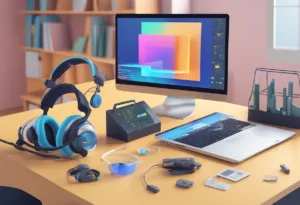
What are some successful examples of augmented reality applied in corporate training programs?
Augmented reality has been successfully applied in various corporate training programs. For instance, Walmart has used AR technology to train its employees on customer service and compliance with safety procedures. Similarly, Boeing has used AR to train its technicians on complex assembly processes. Another example is the use of AR by medical device manufacturers to train surgeons on the use of their products.
How does augmented reality enhance the learning experience in professional development?
Augmented reality enhances the learning experience in professional development by providing a more immersive and interactive experience. AR allows trainees to visualize complex concepts and processes in a more tangible way, making it easier to understand and retain information. It also allows for real-time feedback and assessment, which can help identify areas for improvement and enhance the learning process.
Which industries have effectively integrated augmented reality into their training processes?
Several industries have effectively integrated augmented reality into their training processes. These include manufacturing, healthcare, retail, and aviation. In manufacturing, AR is used to train technicians on assembly processes and maintenance procedures. In healthcare, AR is used to train surgeons on complex procedures and to simulate medical emergencies. In retail, AR is used to train employees on customer service and compliance with safety procedures. In aviation, AR is used to train pilots on emergency procedures and to simulate various weather conditions.
What are the differences between virtual reality and augmented reality in the context of training?
Virtual reality and augmented reality are both used in training, but they differ in their approach. Virtual reality creates a completely immersive environment that can simulate real-life scenarios, while augmented reality overlays digital information onto the real world. In the context of training, virtual reality is often used for high-risk or dangerous scenarios, such as flight simulations or emergency response training. Augmented reality, on the other hand, is often used for more practical applications, such as product demonstrations or equipment maintenance.
Can AR technologies improve the efficiency of technical skill acquisition in training?
Yes, AR technologies can improve the efficiency of technical skill acquisition in training. AR allows trainees to visualize complex processes in a more tangible way, making it easier to understand and retain information. It also allows for real-time feedback and assessment, which can help identify areas for improvement and enhance the learning process. AR can reduce the need for physical equipment or resources, making training more cost-effective and accessible.
What are the key features to look for in augmented reality training software?
When evaluating augmented reality training software, it’s important to look for key features such as ease of use, interactivity, and customization. The software should be user-friendly and intuitive, with clear instructions and feedback. It should also allow for interactive and engaging experiences, such as simulations or gamification. Finally, it should be customizable to fit the specific needs and goals of the training program, with the ability to create and modify content as needed.

